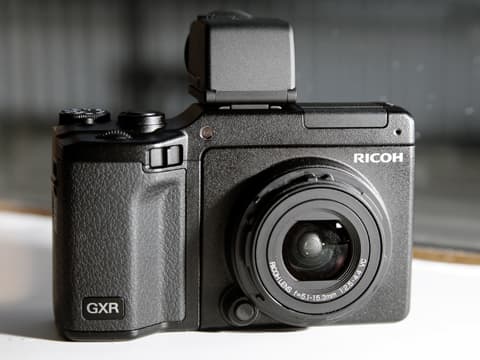Ricoh has unveiled the GXR, an interchangeable lens compact digital camera system that represents a first in its class for camera design.
See here for AP’s exclusive first look and MORE PICTURES
See here for photos shot using the Ricoh GXR
Harbouring ambitions to ‘conquer the DSLR’ the Ricoh GXR is a modular system where the imaging sensor and image processing engine are built into the lens unit, rather that the camera body.
The lens units attach to the GXR camera body using a slide-in mount system.
Initially, there will be two lens/sensor modules available – each separately available – alongside a single magnesium-alloy camera body.
The resolution of the GXR imaging sensors differs in each unit, as well as the focal length of the lenses.
One GXR unit contains a 12.3-million-pixel APS-C size (23.6×15.7mm) CMOS sensor and a 50mm f/2.5 ‘Macro’ lens. Meanwhile, the other houses a smaller 10.4MP (1/1.7in) CCD sensor, alongside a 24-72mm f/2.5-4.4 ‘VC’ lens. The focal lengths stated here are 35mm viewing angle equivalents.
The lenses in each GXR unit are Ricoh-made, the latter boasting an image-sensor shift type camera shake correction. The 50mm optic contains a manual focusing ring.
Photographers will be able to change the lens unit to ‘match the scene being photographed’, explained Ricoh.
The firm added: ‘The adoption of this new system has made it possible to achieve both pocket-size for go-anywhere portability and the highest image quality for every photographic situation and subject.’
Housing the sensor in the same unit as the lens will also help prevent the intrusion of dirt and dust, because the sensor is ‘not exposed when lenses are changed’, claimed Ricoh.
The firm’s bosses say they plan to launch more lens units for the GXR system in the second quarter of next year, but they were not yet prepared divulge details.
Ricoh may also launch other camera bodies in future, according to Kazunobu Saiki, general manager for Ricoh’s global camera division, in an interview with AP.
Saiki hinted at the possibility of combining a zoom lens with an APS-C size sensor.
However, he refused to be drawn on whether a full-frame [35mm film size] sensor is in the offing.
Neither would Ricoh reveal who makes the imaging sensors for the GXR system.
Due out on an unspecified date in December, the camera will cost £419 (body only). The 50mm lens unit will be priced £600 and the 24-70mm unit, £330. The VF-2 will cost £219.99.
Features shared by both sensors include raw file recording and a top equivalent ISO of 3200.
The APS-C unit includes an HD movie mode (1,280×720 pixels at 24 frames per second). The 10.4MP unit shoots videos at a maximum resolution of 640×480 pixels, 30fps).
The GXR will be compatible with an external TTL flash unit (GF-1), though this cannot be used at the same time as the optional LCD viewfinder [VF-2].
The camera attaches to the lens unit using a 66-pin connector, the modules communicating using two type of signal. One signal sends image information to the camera body at high speed. A second, slower, signal communicates command information between the two, according to Saiki.
The GXR can also be used with the wide conversion lens (DW-6) and teleconversion (TC-1) unit. This extends the available zoom capability of the GXR to 19-135mm.




Picture: Mr Kazunobu Saiki, general manager for Ricoh?s global camera division with the GXR system: Pic credit: Damien Demolder







